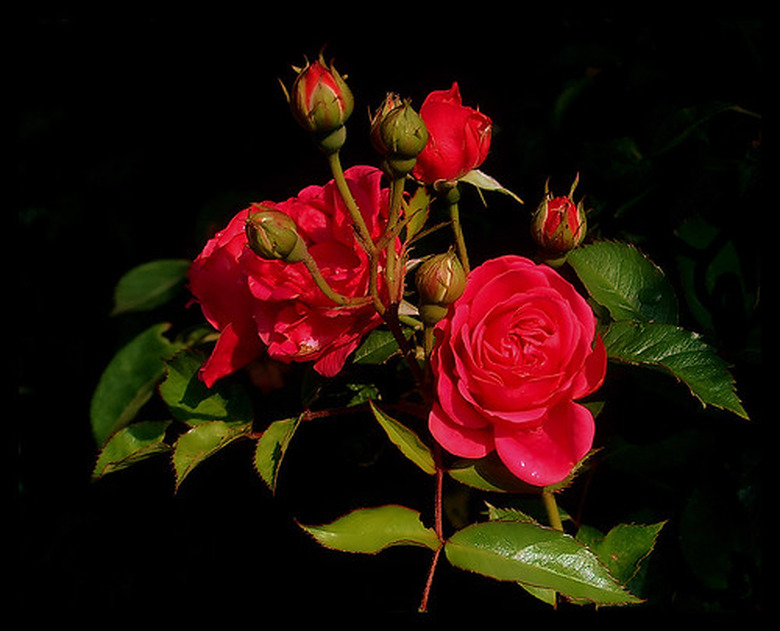Rose Plant Habitats
Roses are garden favorites. Given the proper habitat, roses can be quite resilient. They have many different varieties that provide blooms in a wide range of size and color. Although most are deciduous, some varieties can be evergreen in milder climates. Most varieties require some winter protection. The right amount of protection is important, because too much can actually be more harmful than not having enough.
Climate
Rose varieties with a large number of petals or those with dark colored flowers do not do well in cool summer areas, but pastel colored varieties tend to hold up admirably.
- Roses are garden favorites.
- Rose varieties with a large number of petals or those with dark colored flowers do not do well in cool summer areas, but pastel colored varieties tend to hold up admirably.
Flowers with more petals seem to fare better in a hot-summer climate, where roses grow vigorously, but blooms open quickly, some colors appear to fade, and dark reds can sunburn. Blooms can be made to last longer with afternoon shade.
Colder winter zones require some form of winter protection. Smaller bushes are produced where winters are cold with short growing seasons.
Planting Locations
Roses do best in full sun. Plant away from tree and shrub roots that could take away needed water. Locations with good air circulation, out of strong winds, and good spacing between plants, lessen the chance of foliar diseases.
- Flowers with more petals seem to fare better in a hot-summer climate, where roses grow vigorously, but blooms open quickly, some colors appear to fade, and dark reds can sunburn.
- Locations with good air circulation, out of strong winds, and good spacing between plants, lessen the chance of foliar diseases.
Roses prefer well drained soil or raised beds. Rose beds should be deeply dug with generous amounts of organic matter added. Compost can serve as organic matter and nutrient-rich fertilizer.
Basic Needs
Roses require consistently moist soil throughout the growing season. Deep supplemental watering may be needed, depending on soil type and weather. Watering methods include basin flooding for individual roses, or drip irrigation and overhead sprinkling for mass watering. Mulch maintains moisture and prevents hard baked soil, provides cooling, deters weeds, and promotes healthy soil structure.
- Roses prefer well drained soil or raised beds.
- Deep supplemental watering may be needed, depending on soil type and weather.
For proper nutrition, commercial or organic fertilizer should be applied as growth begins and when bloom period ends. Compost tea can be administered during basin watering or by spraying plants.
Disease and Pest Control
Roses are susceptible to aphids, spider mites, and thrips. Natural predators may be effective in deterring these destructive insects.
Foliar diseases include mildew, rust and black spot. General garden clean up to remove dead leaves and debris and a spray of lime sulfur will destroy many disease organisms and insect eggs. Anthracnose and downy mildew may also affect roses. Spray with a zinc based fungicide when these fungal diseases appear. Plants infected with mosaic virus should be removed from the garden.
- For proper nutrition, commercial or organic fertilizer should be applied as growth begins and when bloom period ends.
- Plants infected with mosaic virus should be removed from the garden.
Winter Protection
Winter protection is required where temperatures regularly reach 10 degrees Fahrenheit. Do not fertilize six weeks before the first hard frost, and leave the last blooms to form hips and stop growth through the ripening process. Water well, right up until soil freezes.
After frost, but before hard freezes, mound extra soil around the base of the plant, making a hill about eight inches high. Cut back long canes to about four feet and tie together with soft twine for wind protection. After soil mound has frozen, mulch with evergreen boughs or straw, keeping mound frozen and preventing alternating freezes and thaws. In extremely cold climates dig a trench, loosen the soil ball, and tip so the rose lays over into the trench and cover with soil.
- Winter protection is required where temperatures regularly reach 10 degrees Fahrenheit.
- In extremely cold climates dig a trench, loosen the soil ball, and tip so the rose lays over into the trench and cover with soil.
Remove winter protection in early spring, after threat of hard frosts has passed.
References
- Sunset Books and Sunset Magazine, eds. "Sunset Western Garden Book". Menlo Park: Sunset Publishing Corporation, 1998.
- Dietz, Majorie J., ed. "10,000 Garden Questions Answered by 20 Experts". Garden City: Doubleday Book & Music Clubs, Inc., 1982.
